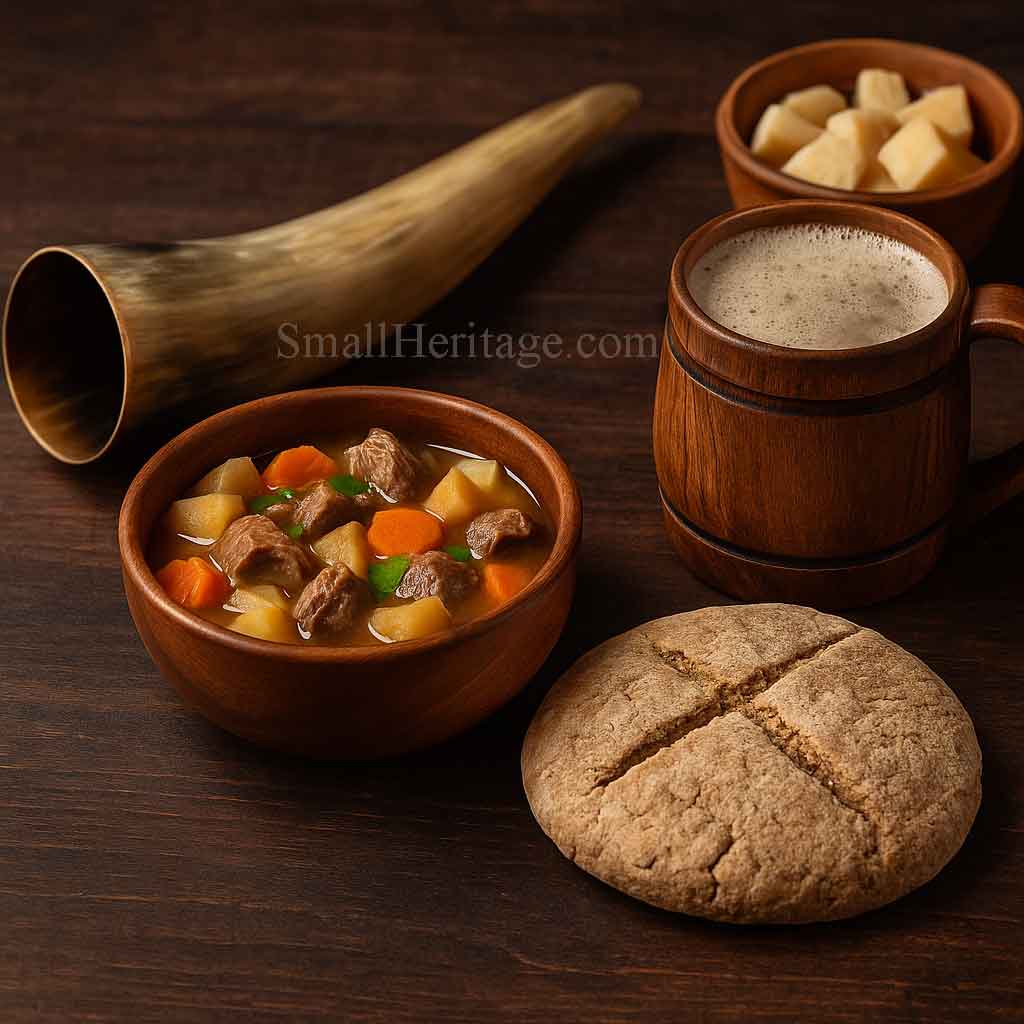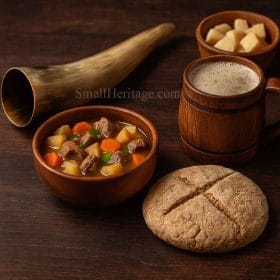
-
Shop by Type
-
Shop by Culture
-
Collections
Home » Blog » Norse & Viking » Viking Food and Viking Recipes: Authentic Norse Dishes

Viking food reflected the resilience and resourcefulness of Norse society. Rooted in harsh Scandinavian landscapes, their cuisine depended on locally available grains, meat, fish, and foraged plants. Preservation techniques such as drying, smoking, and fermenting allowed survival through long winters and sea voyages.
Although few written recipes survive, scholars reconstruct Viking meals through sagas, archeology, and Scandinavian folk traditions. Rustic breads, hearty stews, and fermented drinks echo the Viking kitchen, where longhouse hearths provided warmth and sustenance.
Feasts marked victories, marriages, and religious observances. Large joints of roasted meat, mead, and ale were served, symbolizing strength and abundance. These occasions also reinforced social bonds, making food central to Norse identity.

Daily meals were simpler, focused on nourishment and practicality.
Breakfast often consisted of porridge sweetened with honey or butter, paired with cheese or dried fruit. This combination provided lasting energy for farming and seafaring alike.
The most iconic Viking dish is the stew — adaptable, filling, and easy to prepare. Lamb or beef simmered with leeks, onions, and root vegetables formed a staple meal for families and warriors.
This timeless recipe bridges Viking kitchens with modern households.
Flatbreads made of barley and rye were everyday staples, often baked on hot stones. Dairy provided milk, cheese, and butter. Icelandic skyr, still enjoyed today, is a direct descendant of Viking-era foods.
Preservation was essential for long winters and journeys. Meat was salted, dried, or smoked, while fish such as herring and cod were dried into stockfish. Hunting added deer and wild boar, ensuring a varied protein supply.
Though climate-limited, Norse diets included bilberries, lingonberries, apples, and wild herbs. Foraged nettles, mushrooms, and garlic flavored both everyday meals and special dishes.
No Viking meal was complete without drink. Mead, a honey-based brew, was highly prized, while ale was consumed daily. Fermented whey and buttermilk offered nutritious alternatives.
Vikings used a variety of drinking vessels depending on the occasion and status.
These vessels reflected both the social hierarchy and the festive spirit of Viking culture, turning mead and ale into more than just drinks — they became symbols of hospitality and identity.


Vikings cooked on open hearths using clay, soapstone, or iron vessels. Roasting, boiling, and baking on flat stones reflected a simple but effective culinary tradition.
Modern kitchens can easily recreate Viking recipes using simple ingredients and rustic techniques. These dishes not only bring history to life but also make Norse culture accessible today.
A hearty dish rooted in Norse tradition, combining meat, grains, and seasonal vegetables. For a modern adaptation, see this historically inspired recipe.
Flatbreads, porridges, or berry desserts make excellent educational activities — simple to prepare, fun to eat, and directly connected to Viking heritage.
Today’s cooks can use slow cookers, ovens, and grills to replicate longhouse meals. Authentic Viking flavors are preserved, while preparation is adapted for modern convenience.
In schools, Viking recipes are a hands-on way to bring history into the classroom. Baking bread or preparing a simple stew helps students connect with Norse traditions through taste and activity.